DELTA 36-R31, 36-R51, 36-R53, 36-R31X User guide
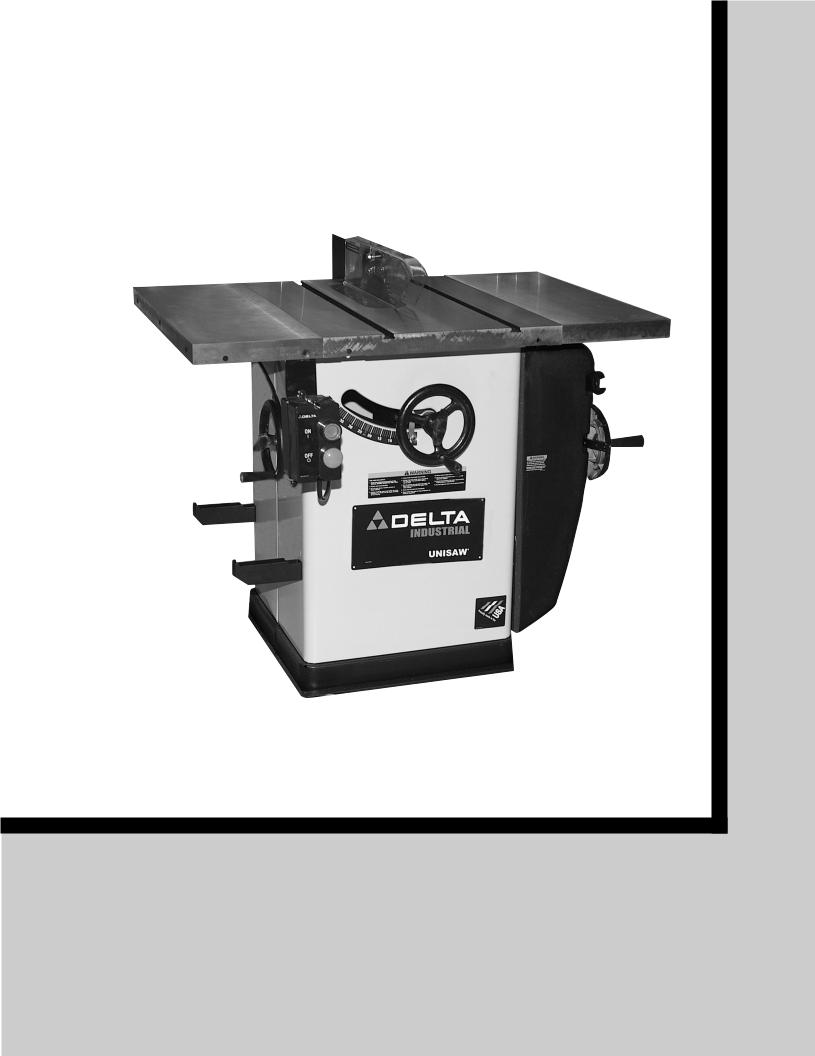
UNISAW® 10" Right Tilting Arbor Saw
(Models 36-R31, 36-R51, 36-R53, 36-R31X)
PART NO. 422-04-651-0069 - 04-15-03
Copyright © 2003 Delta Machinery
To learn more about DELTA MACHINERY
visit our website at: www.deltamachinery.com.
For Parts, Service, Warranty or other Assistance,
please call 1-800-223-7278 (In Canada call 1-800-463-3582).
<![endif]>MANUAL INSTRUCTION
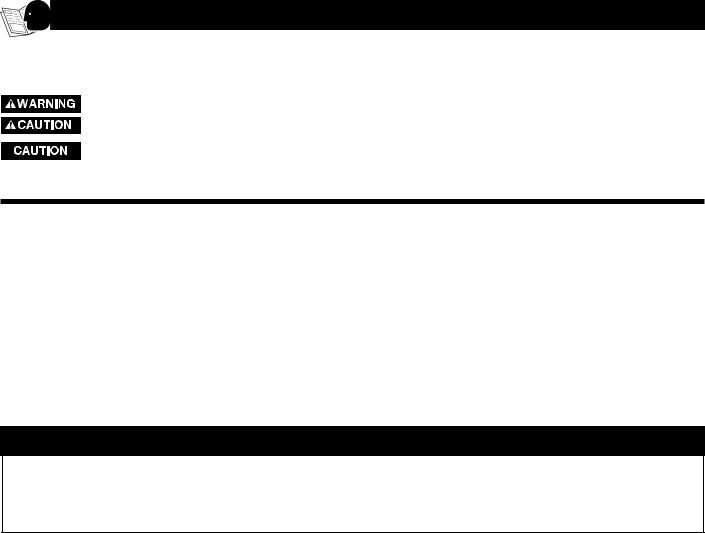
SAFETY GUIDELINES - DEFINITIONS
This manual contains information that is important for you to know and understand. This information relates to protecting YOUR SAFETY and PREVENTING EQUIPMENT PROBLEMS. To help you recognize this information, we use the symbols to the right. Please read the manual and pay attention to these sections.
 Indicates an imminently hazardous situation which, if not avoided, will result in death or serious injury. Indicates a potentially hazardous situation which, if not avoided, could result in death or serious injury.
Indicates an imminently hazardous situation which, if not avoided, will result in death or serious injury. Indicates a potentially hazardous situation which, if not avoided, could result in death or serious injury.
Indicates a potentially hazardous situation which, if not avoided, may result in minor or moderate injury.
Used without the safety alert symbol indicates potentially hazardous situation which, if not avoided, may result in property damage.
 SOME DUST CREATED BY POWER SANDING, SAWING, GRINDING, DRILLING, AND OTHER CONSTRUCTION ACTIVITIES contains chemicals known to cause cancer, birth defects or other reproductive harm. Some examples of these chemicals are:
SOME DUST CREATED BY POWER SANDING, SAWING, GRINDING, DRILLING, AND OTHER CONSTRUCTION ACTIVITIES contains chemicals known to cause cancer, birth defects or other reproductive harm. Some examples of these chemicals are:
·lead from lead-based paints,
·crystalline silica from bricks and cement and other masonry products, and
·arsenic and chromium from chemically-treated lumber.
Your risk from these exposures varies, depending on how often you do this type of work. To reduce your exposure to these chemicals: work in a well ventilated area, and work with approved safety equipment, always wear MSHA/NIOSH approved, properly fitting face mask or respirator when using such tools.
GENERAL SAFETY RULES
 READ AND UNDERSTAND ALL WARNINGS AND OPERATING INSTRUCTIONS BEFORE USING THIS EQUIPMENT. Failure to follow all instructions listed below, may result in electric shock, fire, and/or serious personal injury or property damage.
READ AND UNDERSTAND ALL WARNINGS AND OPERATING INSTRUCTIONS BEFORE USING THIS EQUIPMENT. Failure to follow all instructions listed below, may result in electric shock, fire, and/or serious personal injury or property damage.
SAVE! IMPORTANT SAFETY INSTRUCTIONS SAVE!
Woodworking can be dangerous if safe and proper operating procedures are not followed. As with all machinery, there are certain hazards involved with the operation of the product. Using the machine with respect and caution will considerably lessen the possibility of personal injury. However, if normal safety precautions are overlooked or ignored, personal injury to the operator may result. Safety equipment such as guards, push sticks, hold-downs, featherboards, goggles, dust masks and hearing protection can reduce your potential for injury. But even the best guard won’t make up for poor judgment, carelessness or inattention. Always use common sense and exercise caution in the workshop. If a procedure feels dangerous, don’t try it. Figure out an alternative procedure that feels safer. REMEMBER: Your personal safety is your responsibility.
This machine was designed for certain applications only. Delta Machinery strongly recommends that this machine not be modified and/or used for any application other than that for which it was designed. If you have any questions relative to a particular application, DO NOT use the machine until you have first contacted Delta to determine if it can or should be performed on the product.
Technical Service Manager Delta Machinery
4825 Highway 45 North Jackson, TN 38305
(IN CANADA: 505 SOUTHGATE DRIVE, GUELPH, ONTARIO N1H 6M7)
www.deltamachinery.com
2

FAILURE TO FOLLOW THESE RULES MAY RESULT IN SERIOUS PERSONAL INJURY.
1.FOR YOUR OWN SAFETY, READ THE INSTRUCTTION MANUAL BEFORE OPERATING THE MACHINE. Learning the machine’s application, limitations, and specific hazards will greatly minimize the possibility of accidents and injury.
2.USE CERTIFIED SAFETY EQUIPMENT. Eye protection equipment should comply with ANSI Z87.1 standards, hearing equipment should comply with ANSI S3.19 standards, and dust mask protection should comply with MSHA/NIOSH certified respirator standards. Splinters, air-borne debris, and dust can cause irritation, injury, and/or illness.
3.DRESS PROPERLY. Do not wear tie, gloves, or loose clothing. Remove watch, rings, and other jewelry. Roll up your sleeves. Clothing or jewelry caught in moving parts can cause injury.
4.DO NOT USE THE MACHINE IN A DANGEROUS ENVIRONMENT. The use of power tools in damp or wet locations or in rain can cause shock or electrocution. Keep your work area well-lit to prevent tripping or placing arms, hands, and fingers in danger.
5.MAINTAIN ALL TOOLS AND MACHINES IN PEAK CONDITION. Keep tools sharp and clean for best and safest performance. Follow instructions for lubricating and changing accessories. Poorly maintained tools and machines can further damage the tool or machine and/or cause injury.
6.CHECK FOR DAMAGED PARTS. Before using the machine, check for any damaged parts. Check for alignment of moving parts, binding of moving parts, breakage of parts, and any other conditions that may affect its operation. A guard or any other part that is damaged should be properly repaired or replaced. Damaged parts can cause further damage to the machine and/or injury.
7.KEEP THE WORK AREA CLEAN. Cluttered areas and benches invite accidents.
8.KEEP CHILDREN AND VISITORS AWAY. Your shop is a potentially dangerous environment. Children and visitors can be injured.
9.REDUCE THE RISK OF UNINTENTIONAL STARTING.
Make sure that the switch is in the “OFF” position before plugging in the power cord. In the event of a power failure, move the switch to the “OFF” position. An accidental start-up can cause injury.
10.USE THE GUARDS. Check to see that all guards are in place, secured, and working correctly to prevent injury.
11.REMOVE ADJUSTING KEYS AND WRENCHES BEFORE STARTING THE MACHINE. Tools, scrap pieces, and other debris can be thrown at high speed, causing injury.
12.USE THE RIGHT MACHINE. Don’t force a machine or an attachment to do a job for which it was not designed. Damage to the machine and/or injury may result.
13.USE RECOMMENDED ACCESSORIES. The use of accessories and attachments not recommended by Delta may cause damage to the machine or injury to the user.
14.USE THE PROPER EXTENSION CORD. Make sure your extension cord is in good condition. When using an extension cord, be sure to use one heavy enough to carry the current your product will draw. An undersized cord will cause a drop in line voltage, resulting in loss of power and overheating. See the Extension Cord Chart for the correct size depending on the cord length and nameplate ampere rating. If in doubt, use the next heavier gauge. The smaller the gauge number, the heavier the cord.
15.SECURE THE WORKPIECE. Use clamps or a vise to hold the workpiece when practical. Loss of control of a workpiece can cause injury.
16.FEED THE WORKPIECE AGAINST THE DIRECTION OF THE ROTATION OF THE BLADE, CUTTER, OR ABRASIVE SURFACE. Feeding it from the other direction will cause the workpiece to be thrown out a high speed.
17.DON’T FORCE THE WORKPIECE ON THE MACHINE. Damage to the machine and/or injury may result.
18.DON’T OVERREACH. Loss of balance can make you fall into a working machine, causing injury.
19.NEVER STAND ON THE MACHINE. Injury could occur if the tool tips, or if you accidentally contact the cutting tool.
20.NEVER LEAVE THE MACHINE RUNNING UNATTENDED. TURN THE POWER OFF. Don’t leave the machine until it comes to a complete stop. A child or visitor could be injured.
21.TURN THE MACHINE “OFF”, AND DISCONNECT THE MACHINE FROM THE POWER SOURCE before installing or removing accessories, before adjusting or changing set-ups, or when making repairs. An accidental start-up can cause injury.
22.MAKE YOUR WORKSHOP CHILDPROOF WITH PADLOCKS, MASTER SWITCHES, OR BY REMOVING STARTER KEYS. The accidental start-up of a machine by a child or visitor could cause injury.
23. STAY ALERT, WATCH WHAT YOU ARE DOING,
AND USE COMMON SENSE. DO NOT USE THE MACHINE WHEN YOU ARE TIRED OR UNDER THE INFLUENCE OF DRUGS, ALCOHOL, OR MEDICATION. A moment of inattention while operating power tools may result in injury.
24.THE DUST GENERATED by certain woods and wood products can be injurious to your health. Always operate machinery in well-ventilated areas, and provide for proper dust removal. Use wood dust collection systems whenever possible.
3

ADDITIONAL SAFETY RULES
FOR CIRCULAR SAWS
FAILURE TO FOLLOW THESE RULES MAY RESULT IN SERIOUS PERSONAL INJURY.
1.DO NOT OPERATE THIS MACHINE until it is assembled and installed according to the instructions.
2.OBTAIN ADVICE FROM YOUR SUPERVISOR, instructor, or another qualified person if you are not familiar with the operation of this machine.
3.FOLLOW ALL WIRING CODES and recommended electrical connections.
4.USE THE GUARDS WHENEVER POSSIBLE.
Check to see that they are in place, secured, and working correctly.
5.AVOID KICKBACK by:
A.keeping blade sharp and free of rust and pitch.
B.keeping rip fence parallel to the saw blade.
C.using saw blade guard and spreader for every possible operation, including all through sawing.
D.pushing the workpiece past the saw blade prior to release.
E.never ripping a workpiece that is twisted or warped, or does not have a straight edge to guide along the fence.
F.using feather boards when the anti-kickback device cannot be used.
G.never sawing a large workpiece that cannot be controlled.
H.never using the fence as a guide when crosscutting.
I.never sawing a workpiece with loose knots or other flaws.
6.ALWAYS USE GUARDS, SPLITTER, AND ANTIKICKBACK FINGERS except when otherwise directed in the manual.
7.REMOVE CUT-OFF PIECES AND SCRAPS from the table before starting the saw. The vibration of the machine may cause them to move into the saw blade and be thrown out. After cutting, turn the machine off. When the blade has come to a complete stop, remove all debris.
8.NEVER START THE MACHINE with the workpiece against the blade.
9.HOLD THE WORKPIECE FIRMLY against the miter gauge or fence.
10.NEVER run the workpiece between the fence and a moulding cutterhead.
11.NEVER perform “free-hand” operations. Use either the fence or miter gauge to position and guide the workpiece.
12.USE PUSH STICK(S) for ripping a narrow workpiece.
13.AVOID AWKWARD OPERATIONS AND HAND POSITIONS where a sudden slip could cause a hand to move into the blade.
14.KEEP ARMS, HANDS, AND FINGERS away from the blade.
15.NEVER have any part of your body in line with the path of the saw blade.
16.NEVER REACH AROUND or over the saw blade.
17.NEVER attempt to free a stalled saw blade without first turning the machine “OFF”.
18.PROPERLY SUPPORT LONG OR WIDE workpieces.
19.NEVER PERFORM LAYOUT, assembly or set-up work on the table/work area when the machine is running.
20.TURN THE MACHINE “OFF” AND DISCONNECT THE MACHINE from the power source before installing or removing accessories, before adjusting or changing set-ups, or when making repairs.
21.TURN THE MACHINE “OFF”, disconnect the machine from the power source, and clean the table/work area before leaving the machine. LOCK THE SWITCH IN THE “OFF” POSITION to prevent unauthorized use.
22.ADDITIONAL INFORMATION regarding the safe and proper operation of this machine, including a safety video, is available from the Power Tool Institute, 1300 Sumner Avenue, Cleveland, OH 44115-2851 (www.powertoolinstitute.com). Information is also available from the National Safety Council, 1121 Spring Lake Drive, Itasca, IL 60143-3201. Please refer to the American National Standards Institute ANSI 01.1 Safety Requirements for Woodworking Machines and the U.S. Department of Labor OSHA 1910.213 Regulations.
SAVE THESE INSTRUCTIONS.
Refer to them often and use them to instruct others.
4

POWER CONNECTIONS
A separate electrical circuit should be used for your machines. This circuit should not be less than #12 wire and should be protected with a 20 Amp time lag fuse. If an extension cord is used, use only 3-wire extension cords which have 3- prong grounding type plugs and matching receptacle which will accept the machine’s plug. Before connecting the machine to the power line, make sure the switch is in the “OFF” position and be sure that the electric current is of the same characteristics as indicated on the machine. All line connections should make good contact. Running on low voltage will damage the machine.
DO NOT EXPOSE THE MACHINE TO RAIN OR OPERATE THE MACHINE IN DAMP LOCATIONS.
MOTOR SPECIFICATIONS
Your machine is wired for 230 volt, 60 HZ alternating current. Before connecting the machine to the power source, make sure the switch is in the “OFF” position.
GROUNDING INSTRUCTIONS
 THIS MACHINE MUST BE GROUNDED WHILE IN USE TO PROTECT THE OPERATOR FROM ELECTRIC SHOCK.
THIS MACHINE MUST BE GROUNDED WHILE IN USE TO PROTECT THE OPERATOR FROM ELECTRIC SHOCK.
1. All grounded, cord-connected machines:
In the event of a malfunction or breakdown, grounding provides a path of least resistance for electric current to reduce the risk of electric shock. This machine is equipped with an electric cord having an equipmentgrounding conductor and a grounding plug. The plug must be plugged into a matching outlet that is properly installed and grounded in accordance with all local codes and ordinances.
Do not modify the plug provided - if it will not fit the outlet, have the proper outlet installed by a qualified electrician.
Improper connection of the equipment-grounding conductor can result in risk of electric shock. The conductor with insulation having an outer surface that is green with or without yellow stripes is the equipmentgrounding conductor. If repair or replacement of the electric cord or plug is necessary, do not connect the equipment-grounding conductor to a live terminal.
Check with a qualified electrician or service personnel if the grounding instructions are not completely understood, or if in doubt as to whether the machine is properly grounded.
Use only 3-wire extension cords that have 3-prong grounding type plugs and matching 3-conductor receptacles that accept the machine’s plug, as shown in Fig. C.
Repair or replace damaged or worn cord immediately.
2. Grounded, cord-connected machines intended for use on a supply circuit having a nominal rating between 150 - 250 volts, inclusive:
If the machine is intended for use on a circuit that has an outlet that looks like the one illustrated in Fig. C, the machine will have a grounding plug that looks like the plug illustrated in Fig. C. Make sure the machine is connected to an outlet having the same configuration as the plug. No adapter is available or should be used with this machine. If the machine must be re-connected for use on a different type of electric circuit, the reconnection should be made by qualified service personnel; and after re-connection, the machine should comply with all local codes and ordinances.
 IN ALL CASES, MAKE CERTAIN THE R E C E P TA C L E I N Q U E S T I O N I S P R O P E R LY GROUNDED. IF YOU ARE NOT SURE HAVE A QUALIFIED ELECTRICIAN CHECK THE RECEPTACLE.
IN ALL CASES, MAKE CERTAIN THE R E C E P TA C L E I N Q U E S T I O N I S P R O P E R LY GROUNDED. IF YOU ARE NOT SURE HAVE A QUALIFIED ELECTRICIAN CHECK THE RECEPTACLE.
3. Permanently connected machines:
If the machine is intended to be permanently connected, the machine should be connected to a grounded metal permanent wiring system, or to a system having an equipment-grounding conductor.
CURRENT |
GROUNDED OUTLET BOX |
CARRYING |
|
PRONGS |
|
GROUNDING BLADE
IS LONGEST OF THE 3 BLADES
Fig. C
5
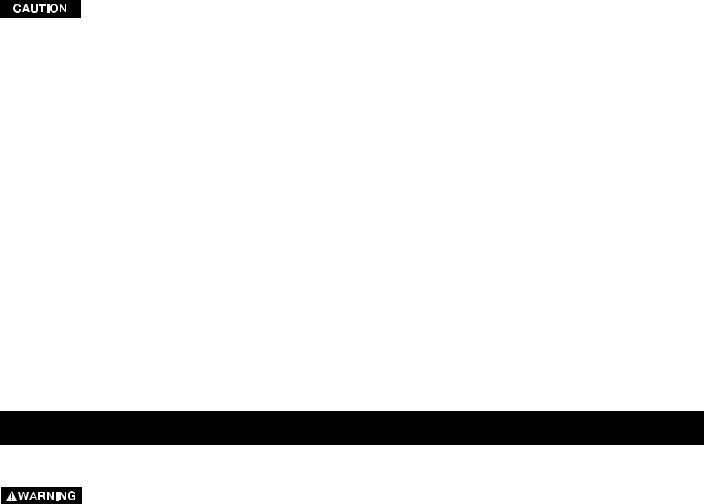
|
|
|
|
|
|
|
|
|
|
|
|
|
|
|
|
|
|
|
|
|
|
|
|
|
|
|
|
|
|
|
|
|
|
|
|
|
|
|
|
|
|
|
|
|
|
|
|
|
|
|
|
|
|
|
Ampere |
|
Total Length |
Gauge of |
|
|
Rating |
Volts |
of Cord in Feet |
Extension Cord |
|
|
0-6 |
240 |
up to 50 |
18 AWG |
|
|
0-6 |
240 |
50-100 |
16 AWG |
|
|
0-6 |
240 |
100-200 |
16 AWG |
|
|
0-6 |
240 |
200-300 |
14 AWG |
|
|
6-10 |
240 |
up to 50 |
18 AWG |
|
|
6-10 |
240 |
50-100 |
16 AWG |
|
|
6-10 |
240 |
100-200 |
14 AWG |
|
|
6-10 |
240 |
200-300 |
12 AWG |
|
|
|
|
|
|
|
|
10-12 |
240 |
up to 50 |
16 AWG |
|
|
10-12 |
240 |
50-100 |
16 AWG |
|
|
10-12 |
240 |
100-200 |
14 AWG |
|
|
10-12 |
240 |
200-300 |
12 AWG |
|
|
|
|
|
|
|
|
12-16 |
240 |
up to 50 |
14 AWG |
|
|
12-16 |
240 |
50-100 |
12 AWG |
|
|
12-16 |
240 |
GREATER THAN 100 FEET NOT RECOMMENDED |
|
|
|
|
|
|
|
|
Fig. D
FUNCTIONAL DESCRIPTION
FOREWORD
The Delta Unisaw is a 10" right tilting arbor saw. The Delta Unisaw features set the standards in the table saw industry.
A RIP FENCE ASSEMBLY IS NOT PACKAGED WITH THE PRODUCT. YOU MUST INSTALL AND USE A RIP FENCE SYSTEM FOR RIPPING OPERATIONS.
NOTICE: THE MANUAL COVER PHOTO ILLUSTRATES THE CURRENT PRODUCTION MODEL 36-R31. ALL OTHER ILLUSTRATIONS ARE REPRESENTATIVE ONLY AND MAY NOT DEPICT THE ACTUAL COLOR, LABELING OR ACCESSORIES AND MAY BE INTENDED TO ILLUSTRATE TECHNIQUE ONLY.
6
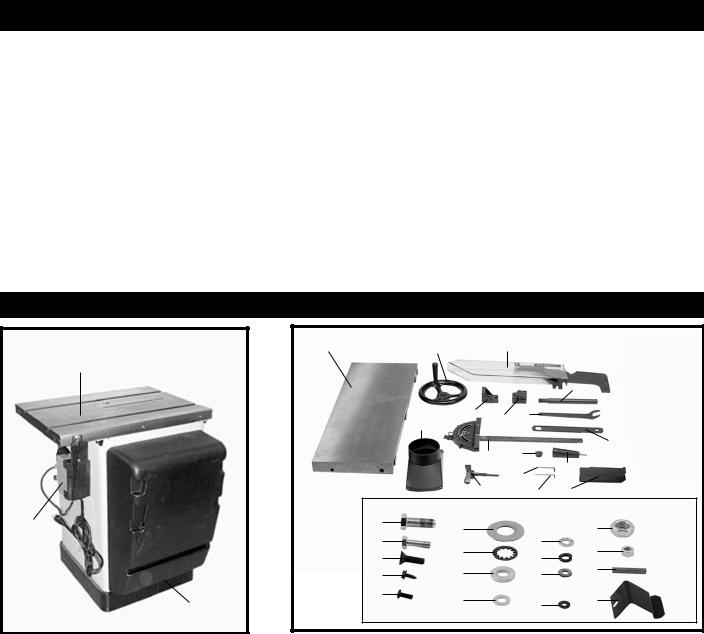
UNPACKING AND CLEANING
Carefully unpack the machine and all loose items from the shipping container(s). Remove the protective coating from all unpainted surfaces. This coating may be removed with a soft cloth moistened with kerosene (do not use acetone, gasoline or lacquer thinner for this purpose). After cleaning, cover the unpainted surfaces with a good quality household floor paste wax.
 REMOVE THE STYROFOAM PACKING AND ANY OTHER LOOSE ITEMS FROM THE INSIDE OF THE SAW CABINET. THE MOTOR COVER MUST BE REMOVED IN ORDER TO REMOVE ITEMS FROM INSIDE THE SAW CABINET. TO REMOVE THE MOTOR COVER, REMOVE THE 1/4-20x5/8" HEX HEAD SCREW FROM LOCATION
REMOVE THE STYROFOAM PACKING AND ANY OTHER LOOSE ITEMS FROM THE INSIDE OF THE SAW CABINET. THE MOTOR COVER MUST BE REMOVED IN ORDER TO REMOVE ITEMS FROM INSIDE THE SAW CABINET. TO REMOVE THE MOTOR COVER, REMOVE THE 1/4-20x5/8" HEX HEAD SCREW FROM LOCATION
(B) FIG. 1, AND PUSH MOTOR COVER TO ONE SIDE TO DEPRESS CLIPS, AND PULL MOTOR COVER OFF. SEE SECTION “MOTOR COVER”.
IMPORTANT: The saw is shipped with the saw arbor in the 45 degree position. NOTE: THE HAND WHEEL MUST BE
ASSEMBLED TO THE SAW, SEE THE SECTION “BLADE TILTING HANDWHEEL”, THEN PROCEED WITH THE FOLLOWING. Loosen locking knob on the handwheel, and turn handwheel until the saw arbor is in the 90 degree position and remove the styrofoam packing from inside the saw cabinet. Tighten locking knob.
UNISAW PARTS
1
2
B
Fig. 1
Fig. 1
1.Unisaw
2.Switch (shown with a GPE switch)
Fig. 2
3.Extension wing (2)
4.Handwheel
5.Blade guard and splitter assembly
6.Upper bracket for splitter
7.Lower bracket for support rod
8.Support rod
9.7/8" Open end arbor wrench
10.7/8"x1/2" Closed end arbor wrench
11.Dust chute
12.Miter gage
13.Cap for miter gage handle
14.Handle for miter gage
15.Handwheel lock knob
16.1/8" Hex wrench
3 |
|
4 |
|
5 |
|
|
|
|
|
|
8 |
|
11 |
6 |
7 |
9 |
|
|
|
|
|||
|
|
|
|
|
|
|
|
|
12 |
13 |
10 |
|
|
|
14 |
||
|
|
|
|
16 |
|
|
|
|
15 |
|
|
|
|
|
17 |
18 |
|
19 |
|
24 |
|
|
32 |
20 |
|
|
28 |
||
|
25 |
|
33 |
||
21 |
|
|
29 |
||
|
26 |
|
34 |
||
22 |
|
|
30 |
||
|
|
|
|||
23 |
|
27 |
|
31 |
35 |
|
|
|
|||
|
|
|
|
|
Fig. 2
17.5/64" Hex wrench
18.Hanger for rip fence (2)
19.7/16-20x1¼" Hex head screw (6)
20.5/16-18x1" Hex head screw (4)
21.5/16-18x1" Flat Head Screw (1)
22.#10x1/2" Hex washer head screw (8)
23.10-32x1/2" Pan head screw (2) ( for use w/ LVC models only)
24.3/4" I.D. Fiber washer (1)
25.5/8" I.D. Internal tooth washer (1)
26.7/16" I.D. Flat washer (6)
27.5/16" I.D. Flat washer (2)
28.5/16" I.D. Flat washer (1) (for use w/ GPE models only)
29.5/16" I.D. Lockwasher (3)
30.1/4" I.D. Fiber washer (1)
31.13/64" I.D. Flat washer (2) (for use w/ LVC models only)
32.5/8-18 Jam nut (1)
33.5/16-18 Hex nut (1) (for use w/ GPE models only)
34.1-3/8" Key (1)
35.Spring clip (2) (for use w/ LVC models only)
7
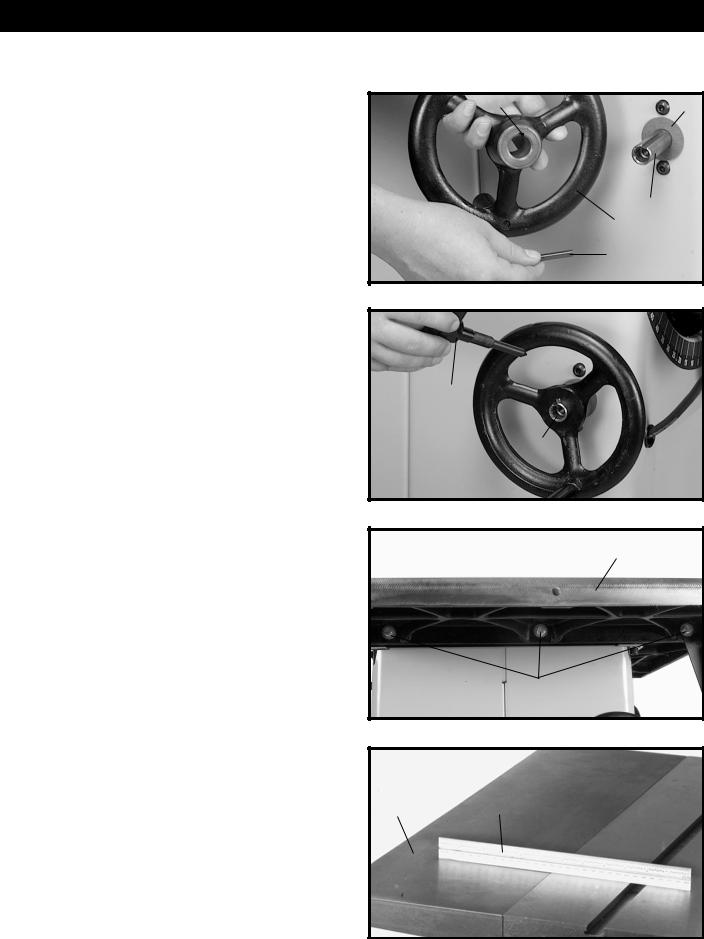
ASSEMBLY
 FOR YOUR OWN SAFETY, DO NOT CONNECT THE MACHINE TO THE POWER SOURCE UNTIL THE MACHINE IS COMPLETELY ASSEMBLED AND YOU READ AND UNDERSTAND THE ENTIRE INSTRUCTION MANUAL.
FOR YOUR OWN SAFETY, DO NOT CONNECT THE MACHINE TO THE POWER SOURCE UNTIL THE MACHINE IS COMPLETELY ASSEMBLED AND YOU READ AND UNDERSTAND THE ENTIRE INSTRUCTION MANUAL.
BLADE TILTING
HANDWHEEL
1.Install fiber washer (A) Fig. 3, on the blade tilting handwheel shaft (B). Install key (C), into shaft keyway.
2.Place handwheel (D) on shaft (B) Fig. 3. Make sure the groove (E), in the handwheel lines up with the key (C).
3.Push the handwheel snugly against the fiber washer and tighten the set screw.
4.Install lock knob (F) Fig. 4, into threaded end of the shaft (B). Hand-tighten lock knob at this time.
EXTENSION WINGS
NOTE: CHECK TO SEE WHAT TYPE OF STARTER BOX WAS SHIPPED WITH YOUR SAW (GPE OR LVC). A GPE STARTER HAS ROUND “ON” AND “OFF” BUTTONS. A LVC STARTER HAS RECTANGLE “ON” AND “OFF” BUTTONS.
NOTE FOR GPE STARTER BOX: If your Unisaw was shipped with an GPE starter box, the GPE “ON/OFF” switch must be removed from the left side of the Unisaw. When assembling the left extension wing, do not install the front screw and washer at this time, it will be installed when assembling the on/off switch.
NOTE FOR LVC STARTER BOX: If your Unisaw was shipped with an LVC starter box, the LVC “ON/OFF” switch must be removed from the left side of the Unisaw. Save the hardware that attached the LVC “ON/OFF” switch to the Unisaw because it will be used to re-attach the “ON/OFF” switch to the left extension wing in the section “ASSEMBLING LVC ON/OFF SWITCH.”
Assemble the extension wing (A) Fig. 5 , to the left side of the saw table using the three 7/16"-20x1¼" hex head screws (B) and 7/16" flat washers supplied. NOTE:
MAKE SURE FRONT EDGE OF WING IS FLUSH TO OR SLIGHTLY BEHIND THE FRONT EDGE OF THE TABLE. Use a straight edge (C) Fig. 6, to make sure the extension wing (A) is level with the saw table before tightening the screws (B) Fig. 5.
Assemble the right extension wing in the same manner.
E A
B
D
C
Fig. 3
F
B
Fig. 4
A |
B |
Fig. 5
A C
Fig. 6
8
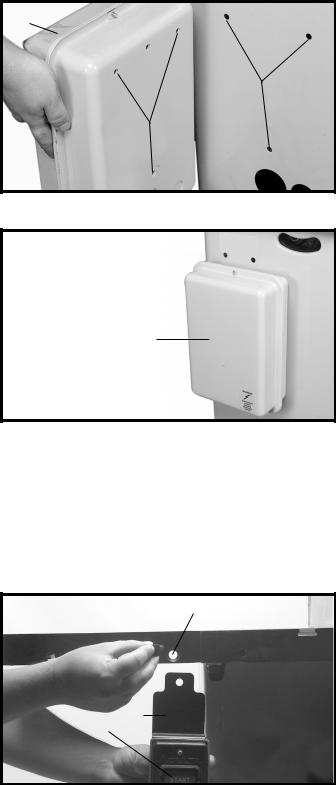
LVC STARTER BOX
TO CABINET
If you purchased the machine with magnetic push button electrical controls (LVC), the saw is shipped with the starter box completely wired to the switch and motor. However, the starter box must be mounted to the saw cabinet. To assemble the starter box (A) Fig. 7, to the saw cabinet, proceed as follows:
1.Place a 1/4" lockwasher then a 1/4" flat washer onto a 1/4-20x1/2" hex head screw. From the inside rear of the saw cabinet, insert the 1/4-20 x 1/2" hex head screw into the hole (B) Fig. 7, in the cabinet. Repeat this process for the two remaining screws.
2.Line up the three tapped holes (C) Fig. 7, in the starter box with the screws and secure the starter box (A), to the saw cabinet.
3.Figure 8 illustrates the starter box (A) assembled to the saw cabinet.
A
B
C
Fig. 7
A
Fig. 8
LVC ON / OFF SWITCH
1.Locate the LVC switch and hardware that was removed in the section “ EXTENSION WING.”
2.Mount the switch bracket (C) Fig. 9, to the inside of through hole D) on the left front edge of the extension wing with the hardware that was removed.
NOTE: If you have a GPE switch see “GPE ON/OFF Switch” instructions.
D
C
A
Fig. 9
9
